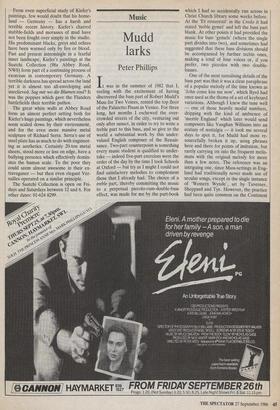Music
Mudd larks
Peter Phillips
It was in the summer of 1982 that I, reeling with the excitement of having discovered the bass part of Robert Mudd's Mass for Two Voices, rented the top floor of the Palazetto Pisani in Venice. For three long, hot months I eschewed the over- crowded streets of the city, venturing out only after sunset, in order to try to write a treble part to this bass, and so give to the world a substantial work by this under- valued English composer of the Renais- sance. Two-part counterpoint is something every music student is qualified to under- take — indeed five-part exercises were the order of the day by the time I took Schools at Oxford — but try as I might I could not find satisfactory melodies to complement those that I already had. The choice of a treble part, thereby committing the music to a perpetual piccolo-cum-double-bass effect, was made for me by the part-book which I had so accidentally run across in Christ Church library some weeks before. At the 'Et resurrexit' in the Credo it had stated 'treble gymel' and left the bass part blank. At other points it had provided the music for bass `gymels' (where the single part divides into two), and sometimes had suggested that these bass divisions should be accompanied by further treble ones, making a total of four voices or, if you prefer, two piccolos with two double- basses.
One of the most tantalising details of the bass part was that it was a clear paraphrase of a popular melody of the time known as `John come kiss me now', which Byrd had once used as the theme of a set of keyboard variations. Although I knew the tune well — one of those heavily modal numbers, dripping with the kind of ambience of `merrie England' which later would send composers like Vaughan Williams into an ecstasy of nostalgia — it took me several days to spot it, for Mudd had most re- sourcefully broken it up, using phrases here and there for points of imitation, but rarely carrying on into the frequent melis- mata with the original melody for more than a few notes. The reference was an intriguing one, since Mass-settings in Eng- land had traditionally never made use of secular songs, except in the single instance of 'Western Wynde', set by Taverner, Sheppard and Tye. However, the practice had been quite common on the Continent
throughout the Renaissance period, most famously with `L'homme aril* and had reached such proportions by the time of the Reformation that the cardinals of the Council of Trent had tried to put a stop to it. Why Mudd should have taken such an unorthodox step for an Englishman cannot be explained. Perhaps he was a recusant showing solidarity with his Catholic col- leagues abroad, as Byrd had done in his shared setting of Psalm 137 with Philip de Monte, or perhaps he was covertly telling the world something of himself. After all, no one knows how the words of the song continue, and thus whether it is a woman or a man who is speaking them.
The coolest room in the Palazetto was, very agreeably, the library. Although these days the Palazzo Pisani, since 1897 the home of the Venetian Conservatory of Music, is now quite separate from its Palazetto, some of the collection of musical manuscripts which the Conservatory inher- ited are housed in this library. From time to time, as I worked at my missing part, conscientiously conjuring with canons eight in one, I would fill my cappuccino breaks by browsing through the volumes displayed about me. In this way 1 became familiar with the works of Giovanni Cian- cia, a singer in the choir of St Mark's between 1572 and about 1580, of whom up to this point I had never heard. His surviving works in that library consist of a set of three part-books, published in Venice in 1575, filled with uncomplicated homophonic villanelle such as many Italian composers of the time wrote. The wholly unusual aspect of these ones is that some have English texts, which, taken together, describe a journey that young Giovanni had made to England in the early 1560s. He had evidently had a good time, making it his business to meet the leading musi- cians of the day, and get drunk with them. John Sheppard, for instance, who crops up in several of the songs, is affectionately referred to as 'the leggeless Pastore', and so on. One of these pieces, published at the end of the volumes with other Italian- texted offerings and perhaps written after Ciancia was thrown out of England for spying, is entitled Roberto, mio caro. A little elementary mathematics showed that this amiable tune had exactly the same metre and number of phrases as John, come kiss me now; and a little further mathematics suggested that by breaking up Ciancia's tune in exactly the way that Mudd had disposed his model, the two could be made to fit very happily together. All I had to do, as editor, to render the work complete, was round off some of the phrases and write the gymels.
Since this was a simple task and took little time, I had leisure to explore the library further. It was some days later that to my astonishment I came upon the manuscript of an opera by Arcangelo Corelli, entitled II caro Sassone. . . .



























































 Previous page
Previous page